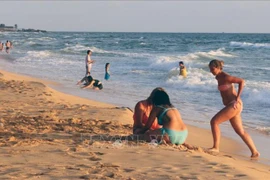KienGiang (VNA) - A oyster breeding project in the Mekong Deltaprovince of Kien Giang which is part of larger effort to preserve andregenerate natural aquatic resources on Phu Quoc island has seen positive results,according to the Phu Quoc Reserve Management Board.
The project, which was approved bythe provincial People’s Committee in 2016 and will last for 20 years, is beingimplemented on Hon Vang island in Phu Quoc district’s Hon Thom commune bythe Phu Quoc Reserve and privateenterprise Ngoc Hien Pearl.
In the project’s first phase from2016 to this year, more than 2.4 million gold-lipped oysters were released intoa pilot breeding area in Hon Vang. The oysters have adapted well to thebreeding environment and have grown rapidly.
The breeding of gold-lipped oystershas helped regenerate natural aquatic species and diversify the ecosystem.High-value aquatic species like painted sweetlip, red grouper, sea urchin andcommercial top shell have appeared in large numbers in the breeding area.
In addition, coral has developedwell with diverse species, mostly hard coral.
The first phase of the project costs10 billion VND (430,000 USD), including fees to build small stilt houses in thesea for monitoring the breeding area, buying buoy marks to identify thebreeding area, and patrolling the breeding area.
An additional 42 million gold-lippedoysters will be released for breeding in the first three years of the project’ssecond phase.
District agencies will also speak tolocals about the value of protection and regeneration of natural aquaticresources.
Quang Trong Thao, Deputy Director ofthe provincial Department of Agriculture and Rural Development, said theproject’s success was expected to attract investors to pour money intoprotecting and regenerating natural aquatic resources, including sea turtles,sea horses and small giant clams.
The regeneration of aquaticresources will help develop the district’s marine economy and tourism, headded.
The district was the first place inthe southern region to breed oysters to harvest pearls, which has been done forabout 30 years in floating cages in the sea.-VNA





























